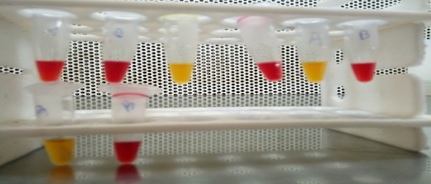In vitro methods of CLSI to detect Carbapenemases in Carbapenem-resistant Enterobacteriaceae
Abstract
Aims: Detection of Carbapenemases production in Carbapenem Resistant Enterobacteriaceae(CRE) using CarbaNP and its comparison with the newer CLSI recommended modified Carbapenemases Inactivation Method(mCIM).
Materials and Methods: 100 isolates of CRE were selected in a period of 3 months from June-August 2018 for the tests, based on MIC values of >= 2mg/ml given by vitek2compact systems. CarbaNP test was performed as per M100, CLSI 2018 guidelines. CarbaNP solutions A and B were prepared and Imipenem-Cilastatin powder was replaced for standard imipenem powder. The reading was taken at the end of 10 mins,30 mins, and 2 hours. mCIM was performed as per CLSI M100,2018. The presence of carbapenemase was indicated by an inhibition zone ≤15mm in diameter. eCIM was also performed in the same way, with 0.1M EDTA added in TSB broth. Descriptive analysis.
Results: Among the 100 CRE isolates, Carba NP detected 71 CP-CRE while mCIM detected 80(80%) of the same. mCIM detected 8 more positives than the carbaNP test. 1 isolate tested positive CarbaNP but tested negative in mCIM.
Conclusion: CarbaNP is a novel protocol recommended by CLSI for detecting CP-CREs and studies prove that it is a very good test in detecting KPC and OXA mediated resistance, while mCIM is said to detect all 5 genes i.e. KPC,NDM,OXA,IMP, and VIM. Carba NP is easy to perform and gives quick results once the reagents are prepared. mCIM on the contrary as a newly developed test detects more CP-CREs but takes more time for the interpretation. However, further confirmation of carbapenemases enzymes with molecular methods in the present study was not done.
Downloads
References
Tamma PD, Goodman KE, Harris AD, Tekle T, Robert A, Taiwo A et al., Comparing the outcomes of patients with carbapenemase-producing and non-carbapenemase-producing carbapenem-resistant enterobacteriaceaebacteremia. Clin Infect Di.s 2017;64(3):257-264. doi: https://doi.org/10.1093/cid/ciw741.
Pierce VM, Simner PJ, Lonsway DR, Roe-Carpenter DE, Johnson JK, Brasso WB, et al., Modified Carbapenem Inactivation Method for Phenotypic Detection of Carbapenemase Production among Enterobacteriaceae. JClin Microbiol. 2017;55(8):2321-2333. doi: https://doi.org/10.1128/JCM.00193-17.
Pragasam AK, Veeraraghavan B, Bakthavatchalam YD, Gopi R, Aslam RF. Strengths and limitations of various screening methods for carbapenem-resistant Enterobacteriaceae including new method recommended by Clinical and Laboratory Standards Institute, 2017: a tertiary care experience. Indian JMed Microbiol. 2017;35(1):116. doi: https://doi.org/10.4103/ijmm.IJMM_17_10.
Rudresh SM, Ravi GS, Sunitha L, Hajira SN, Kalaiarasan E, Harish BN. Simple, rapid, and cost-effective modified Carba NP test for carbapenemase detection among Gram negative bacteria. J Lab Physicians 2017;9(4):303-307. doi: https://doi.org/10.4103/JLP.JLP_138_16.
van der Zwaluw K, de Haan A, Pluister GN, Bootsma HJ, de Neeling AJ, Schouls LM., et al., The carbapenem inactivation method (CIM), a simple and low cost alternative for the Carba NP test to assess phenotypic carbapenemase activity in gram negative rods. PLoS One. 2015;10(3):e0123690. doi: https://doi.org/10.1371/journal.pone.0123690.
Nordmann P, Naas T, Poirel L. Global spread of carbapenemase-producing Enterobacteriaceae. Emerg Infect Dis. 2011;17(10):1791. doi: https://doi.org/10.3201/eid1710.110655.
Tamma PD, Huang Y, Opene BN, Simner PJ. Determining the optimal carbapenem MIC that distinguishes carbapenemase-producing and non-carbapenemase-producing carbapenem-resistant Enterobacteriaceae. Antimicrob Agents Chemother. 2016;60(10):6425-6429. doi: https://doi.org/10.1128/AAC.00838-16.
Tamma PD, Opene BN, Gluck A, Chambers KK, Carroll KC, Simner PJ. Comparison of 11 phenotypic assays for accurate detection of carbapenemase-producing Enterobacteriaceae. J Clin Microbiol. 2017;55(4):1046-1055. doi: https://doi.org/10.1128/JCM.02338-16.
CLSI 2018. Performance standards for antimicrobial susceptibility testing, 28th ed. CLSI supplement M100. Clinical and Laboratory Standards Institute, Wayne, PA.
Masuda G, Tomioka S, Hasegawa M, et al. Detection of beta-lactamase production by gram-negative bacteria. J Antibiot. 1976;29(6):662–664. doi: https://doi.org/10.7164/antibiotics.29.662.
McMullen AR, Yarbrough ML, Wallace MA, Shupe A, Burnham CA. Evaluation of genotypic and phenotypic methods to detect carbapenemase production in Gram-negative bacilli. Clin Chem. 2017;63(3):723-730. doi: https://doi.org/10.1373/clinchem.2016.264804.

Copyright (c) 2020 Author (s). Published by Siddharth Health Research and Social Welfare Society

This work is licensed under a Creative Commons Attribution 4.0 International License.


 OAI - Open Archives Initiative
OAI - Open Archives Initiative


